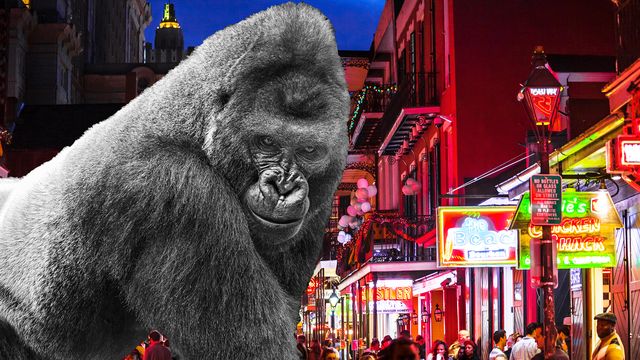- Apes may have survived because of their evolved tolerance for alcohol.
- An evolutionary bottleneck 10 million years ago separated monkeys, who could eat unripe fruit, and apes, who discovered they could survive on fermented, overripe fruit.
- While some animals are affected by alcohol, most avoid it as a matter of preference.
Unlike your one buddy who always gets in brawls, consuming alcohol may have helped apes to survive an existential threat. A new book from Oxford University tackles the history of alcohol use from its earliest beginnings, when great apes were likely forced by circumstance into eating fermented fruit they found on the ground.
An important distinction separated ape populations and monkey populations 10 million years ago, when this behavior is thought to have begun. Monkeys like macaques, marmosets, and spider monkeys could eat and digest unripe fruit, meaning they could get enough calories even from the tough and fibrous stuff. If humans ate these fruits, they’d likely, uh, pass through quickly without our bodies extracting much nutrition. Monkeys were outpacing apes by surviving on the equivalent of crabapples and very green tomatoes.
But apes had an edge of their own: They could digest, or at least tolerate, the ethanol in fruits that had ripened, fallen from trees, and fermented on the forest floor. This gave them access to a food source of their own, and that often trailed further into the end of the growing season than the un-boozy fruits. If only the alcohol-consuming apes survived, this could be why humans can tolerate alcohol today.
Though there are tiny apes (the gibbon, at under 20 pounds) and large monkeys (the mandrill, up to 80 pounds), apes are generally larger and require a lot more calories. Riper fruits, even fermented ones, have more developed sugars and more digestible calories, making them a more energy-dense food source. Low energy density is why the panda bear spends all day, every day sitting still and continuing to gnaw on bamboo just to survive.
The book’s authors stress the role of alcohol in human social life over basically all of history, but alcohol tolerance has helped humans to survive in more direct ways, too. The fermented fruits consumed by long-ago apes likely had the same alcohol content as small beer, a very lightly fermented beverage that people have consumed for thousands of years because of its reduced chance of water-borne illness. People have also relied on wine, and even children were given one or the other as the safest beverage for many centuries.
In the 1800s, distilled hard liquor became more available than ever before in the United States, and you can imagine the system shock of switching from grazing on small beer all day to vodka or even port. This rage of so-called “intemperance” was one of the long-term factors that led to the temperance movement. Quaker and abolitionist John Lettsom set out guidelines for temperate and intemperate alcohol at the turn of the 19th century. Small beer was the most temperate, listed alongside milk and water and showing how important small beer still was to safe daily hydration.
The fruit that apes were eating was probably 1 to 4 percent alcohol, somewhere between small beer and Michelob Ultra. Today, although some animals accidentally eat fermented fruit, these stories are mostly myths—except for your dog lapping beer out of a Frisbee on a hot summer day, which is very real. The African marula fruit is subject to many of these fun rumors, when in reality, it’s humans who ferment the fruits into a beloved local beverage.

Caroline Delbert is a writer, avid reader, and contributing editor at Pop Mech. She's also an enthusiast of just about everything. Her favorite topics include nuclear energy, cosmology, math of everyday things, and the philosophy of it all.












